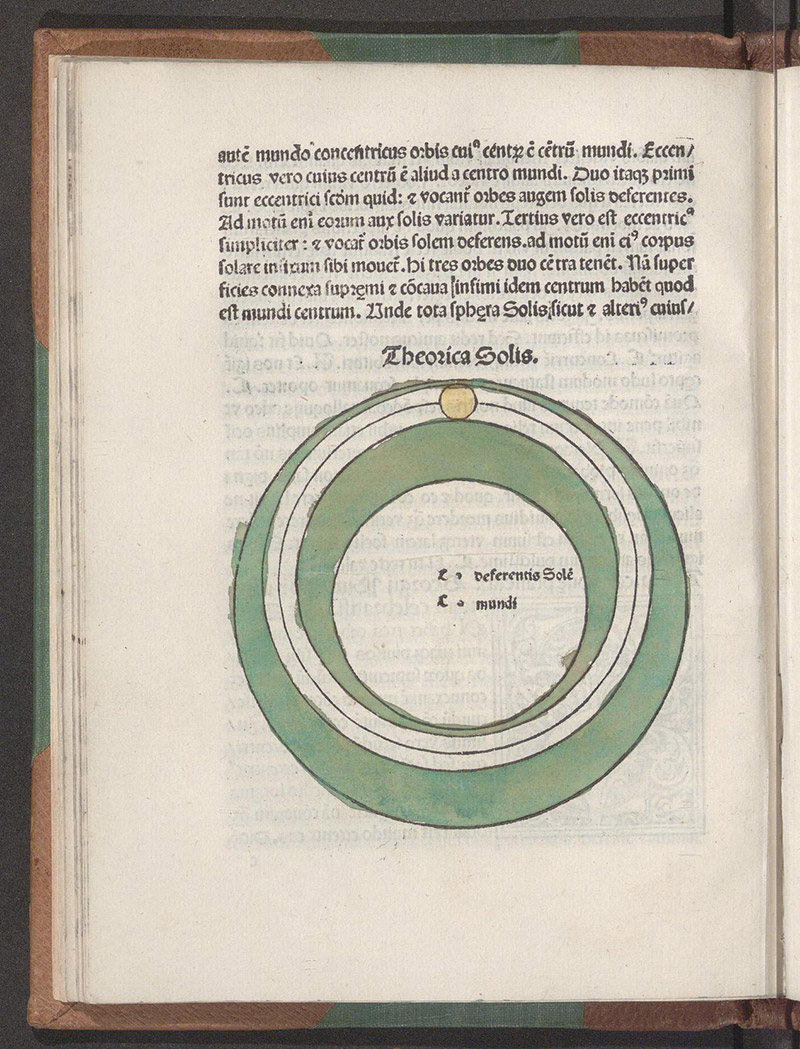Georg Peurbach

- Fol. e1v. Hand-colored woodcut illustrating the movements of the Sun.
- Johannes de Sacrobosco (ca. 1200-ca. 1250): Sphaera mundi. Add: Georgius Purbachius (1421-1461): Theoricae novae planetarum. Johannes Regiomontanus (1436-1476): Disputationes contra Cremonensia deliramenta.
- Venice: Erhard Ratdolt, 6 July 1482.
Georg Peurbach established his great reputation as a professor of mathematics, astronomy, and astrology, at the University of Vienna and as a court astrologer. Peurbach's first royal position was with King Ladislas V of Bohemia and Hungary, and subsequently with Ladislas’ uncle, the Holy Roman emperor Frederick III. Peurbach’s student Johannes Regiomontanus collaborated with his master in numerous projects, including the observation of two comets (one of them being the comet Halley in 1456) and the recording and predictions of lunar eclipses. Peurbach’s best known work was the result of a series of lectures delivered in the Collegium Civium (Bürgerschule) in Vienna in 1454: the Theoricae novae planetarum (The New Theories of the Planets) is an improvement of the old Theorica planetarum. Peurbach’s treatise would regularly appear after Sacrobosco’s Sphaera in many early printed editions such as the one shown here, published by the German printer Erhard Ratdolt in Venice in 1482. Also included in this edition is Johannes Regiomontanus’s critical attack against the old Theorica planetarum: Disputationes contra Cremonensia deliramenta, which was originally published in 1476.
The hand-colored woodcut shown here illustrates Peurbach’s theory of the movement of the Sun. At the beginning of this section, Peurbach explains that the Sun has three orbs. The highest of these orbs is concentric with the world on its convex side, but is eccentric on its concave side. Conversely, the lowest orb is concentric on its concave but eccentric on its convex side. The middle orb is eccentric to the world on both its convex and concave sides. An orb whose center is the center of the world is said to be concentric with the world, whereas an orb whose center is not the center of the world is said to be eccentric. Therefore, the highest and the lowest orbs are eccentric relatively, being called the deferent orbs of the apogee of the Sun. The middle orb is eccentric absolutely and is called the deferent orb of the Sun. The body of the Sun is attached to the middle orb and moves according to its motion. These three orbs have two centers. The convex side of the highest and the concave side of the lowest share the same center: the center of the world. Thus the whole sphere of the Sun, and the whole sphere of any planet, is concentric with the world.
Select Bibliography
- Aiton, E. J. 1987. “Peurbach’s Theoricae Novae Planetarum: A Translation with Commentary.” Osiris 3: 4-43.
- Hellman, C. Doris and Noel M. Swerdlow. 2008. “Peurbach (or Peuerbach), Georg.” In Complete Dictionary of Scientific Biography, Vol. 15 (digital edition). Detroit, MI: Charles Scribner’s Sons: 473-479.
- Pantin, Isabelle. 2012. “The First Phases of the Theoricae Planetarum Printed Tradition (1474-1535): The Evolution of a Genre Observed through its Images.” Journal for the History of Astronomy 43 (1): 3-26.